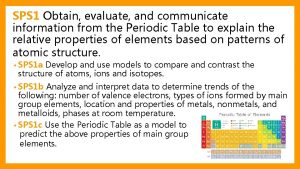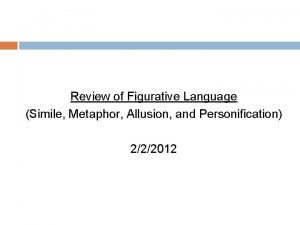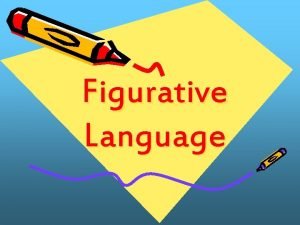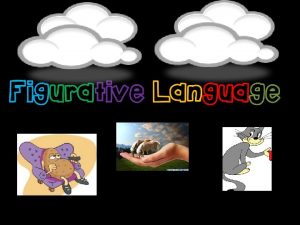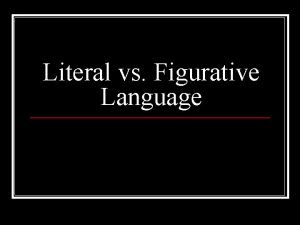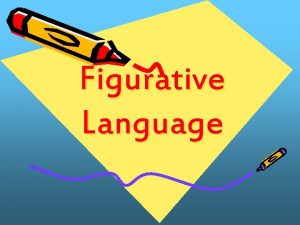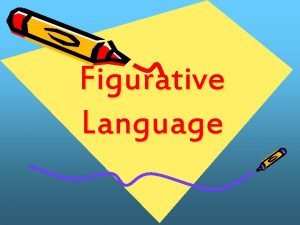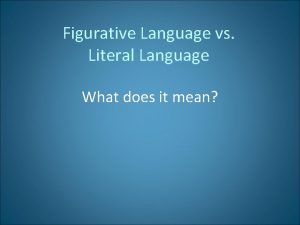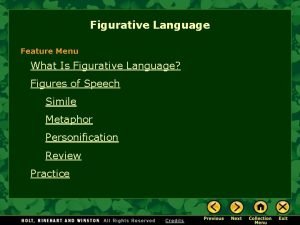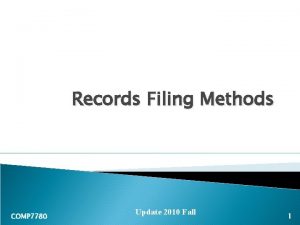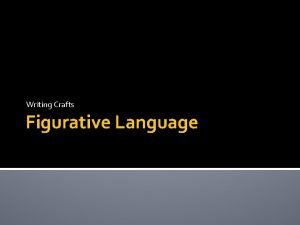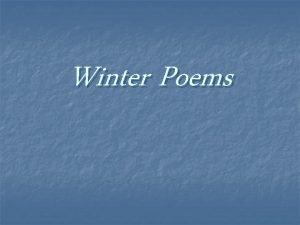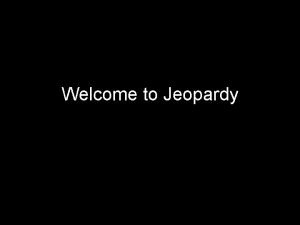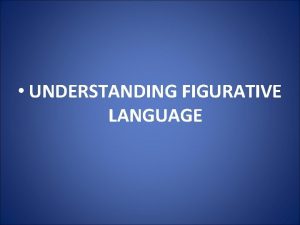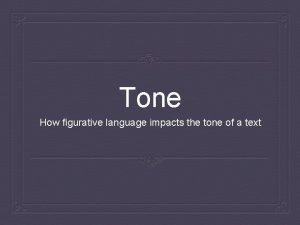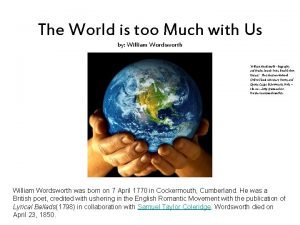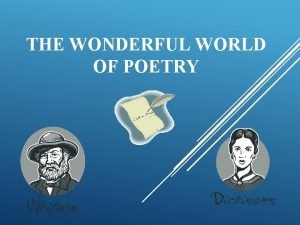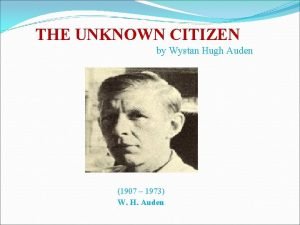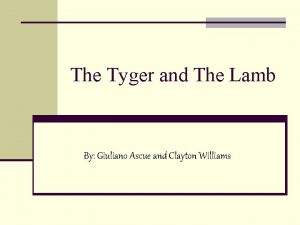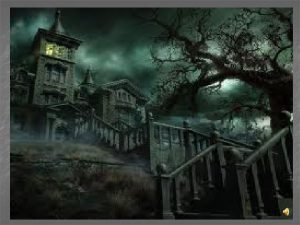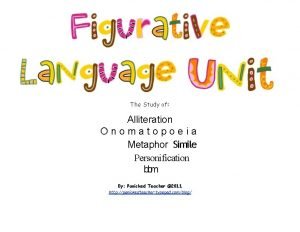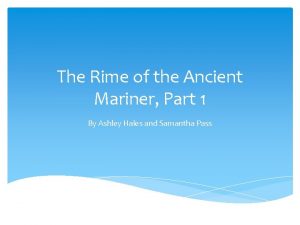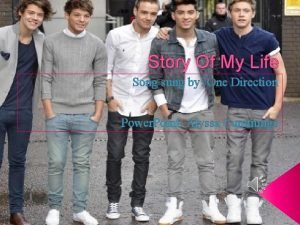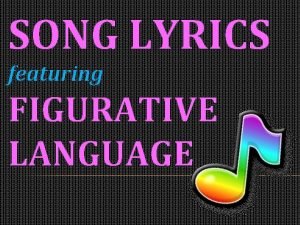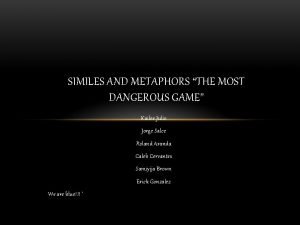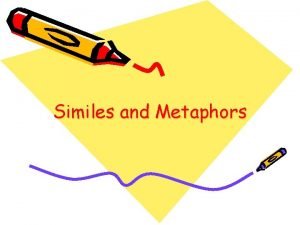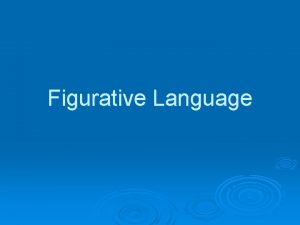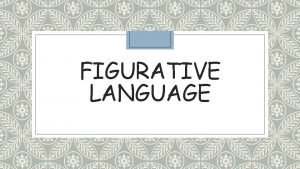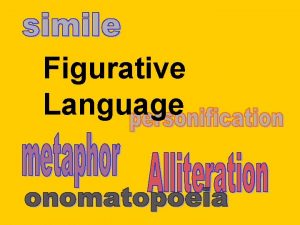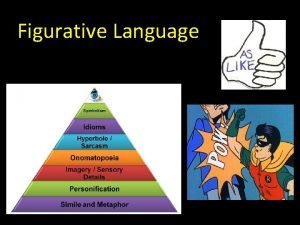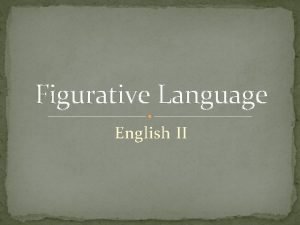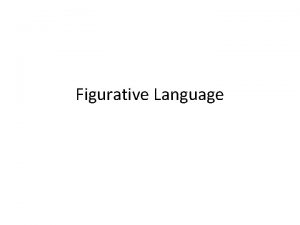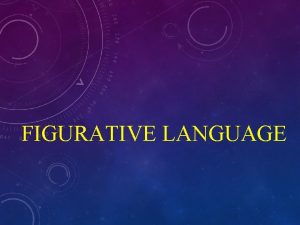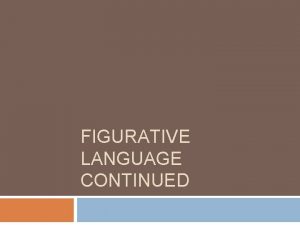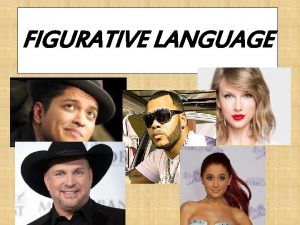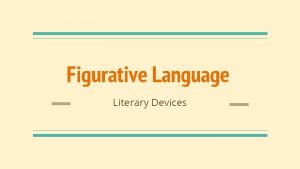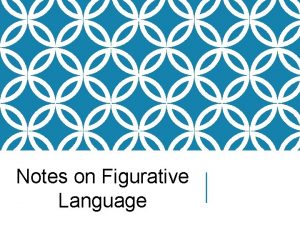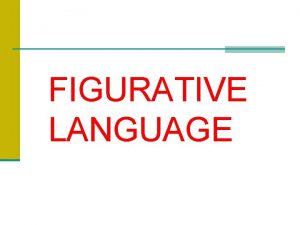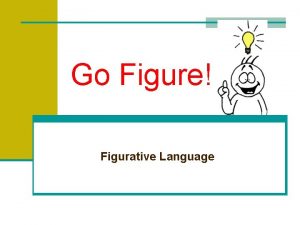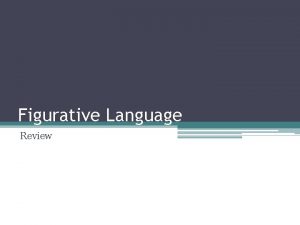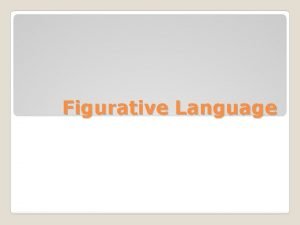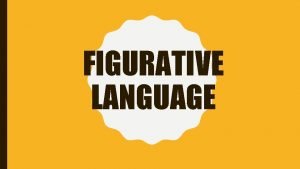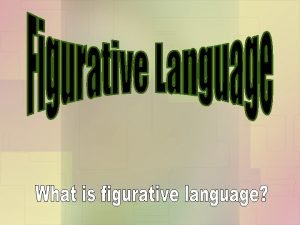ELA EOCT REVIEW General Review Section Figurative Language





























- Slides: 29

ELA EOCT REVIEW

General Review Section

Figurative Language When writers or speakers describe something by comparing it with something else is known as figurative language. Some types of figurative language include: Alliteration – Repetition of the initial consonant sound. Ex: Gary's giraffe gobbled gooseberry's greedily, getting good at grabbing goodies. Hyperbole – Extreme exaggeration. Ex: She is so dumb, she thinks Taco Bell is a Mexican phone company. Idioms – An expression that means something other than the literal meaning of its individual words. Ex: “Speak of the devil!” This means the person you were just talked about comes in the room. Imagery – Appeals to the 5 senses (sight, smell, touch, taste, hear). Ex: The eerie silence was shattered by the girl’s scream.

Figurative Language Continued Metaphor – Comparison of two unlike things NOT using “like” or “as. ” Ex: America is a melting pot. Onomatopoeia – A word that imitates the source of the sound that it describes. Ex: Boom, boom, pow. . . Oxymoron – A figure of speech that combines contradictory or unlike terms. Ex: Be careful on the playground, run slowly. Personification – Giving human like qualities to animals or inanimate objects. Ex: Money is the only friend I can count on. Simile – Comparison using “like” or “as. ” Ex: He is as dumb as a stump.

Context Clues • When reading a text you should use the words and phrases that are around an unfamiliar word to help you understand the meaning of the new word. Using this method of determining a word’s meaning is known as context clues. • THERE ARE DIFFERENT TYPES OF CONTEXT CLUES: definition, restatement (synonym), contrast (antonym), comparison, example, list (series), cause and effect, and description or inference.

Plot and Plot Events (Applies to all 4 units. ) Plot is what happens and how it happens in a narrative, such as a short story, a novel, a drama, or a narrative poem. Ø Exposition– the opening (beginning) situation of the story where the main characters are introduced and the setting is described. Ø Rising Action- events that lead to the climax of the story. They occur as result of central conflict. Ø Conflict – the disagreements, problems, or issues that start in the rising action and take place in the story. Ø Climax- highest point of interest or emotional involvement of the story. The turning point. Ø Falling Action – logical result of climax (events that lead to the resolution) Ø Resolution or Denouement- final outcome of the story where all is revealed. We know how everything turns out.

Theme (Applies to all 4 units. ) • The message or central idea the author wants the reader to understand. Theme often offers insight into life and society. Often, theme is unstated in works of fiction, but may be directly stated in nonfiction, especially in expository or argumentative writing. • Universal Theme: A fundamental ideal developed in a literary work that goes beyond boundaries of race, class, ethnicity, and gender. – Example: The theme of love in Romeo and Juliet.

Tone & Mood (Applies to all 4 units. ) Tone and mood are two literary concepts that people commonly get mixed up. They are related to one another, but are very different concepts. v TONE is the way an author communicates their feelings or attitude toward the subject they are writing about. Tone can be hard to pick up on because you can't hear the author's words as they intended them to be read. Often, you must rely on context clues from the text to determine the tone of a piece of literature. v MOOD is the feeling the READER gets when reading a piece of literature. Ex. Happy, sad, peaceful, etc. In many ways the author’s tone helps set the mood for the reader of the story.

Point of View (Applies to all 4 units. ) How the author allows the reader to “see” and “hear” what is going on in the story is the point of view. • The most commonly used forms of point of view are: 1 st Person used when the narrator is a character in the story. The narrator uses the word “I. ” 3 rd Person Limited used when the narrator only knows the thoughts and feelings of a single character. The narrator does not know ALL. 3 rd Person Omniscient used when the narrator knows the thoughts and feelings of ALL characters in the story.

Formal and Informal Language Formal Language Even when spoken, is often associated with the accepted conventions of written standard English. Does NOT 1. Use contractions 2. Use colloquial or slang vocabulary 3. Use personal pronouns such as: you, I, us, me, and we 1. DOES Use complex, complete sentences Informal Language This form of language does not follow the conventions of standard English. 1. 2. 3. 4. DOES Use simple grammatical structure Use personal evaluation Use contractions Use colloquial or slang vocabulary - Examples: A lot, ain't, gonna, wanna, anyways, kinda, kind of, sorta, sort of, etc.

Formal and Informal Language Continued When should you use Common characteristics of formal and informal or informal language. Use formal… job interview, principal’s Characteristics of formal… office visit, business letter, serious, objective, and class essay impersonal, reasoned, controlled, and reserved Use informal… text message, letter to a friend, casual Characteristics of informal… conversation with friends light, humorous, personal, casual, and family, and personal simple journal-style writing

Unit 1 Review Section

Mythology • Mythology is a body or collection of myths (stories) belonging to a people which addresses their origin, history, deities, ancestors, and heroes. Myths contain heroes/heroines, supernatural elements, gods/goddesses, explain natural phenomenon, and were originally told orally (spoken). Those from the ancient Greeks and Romans are among the world’s most popular myths. Myths were told to help explain the unexplainable, including natural disasters, human nature, to tell about their heroes, and to teach the morals and values of the time.

Character Archetypes • ARCHETYPES are recurring patterns of human behavior, symbolized by standard types of characters in movies and stories. You may have noticed in different books and movies certain characters keep having similar character traits. Some examples of these characters: Hero – must leave their usual life to go on a journey where they overcome challenges & face their fears in order to save the day. Evil villain – capable of crime and wickedness and goes against the story’s hero. Mentor – the wise or holy figure who guides the hero through their journey. Damsel in Distress – the vulnerable female who needs rescuing by the hero.

The Hero’s Journey • The Hero’s Journey is a pattern of 12 stages that appears in drama, storytelling, myth, religious ritual, & psychological development. It describes the typical adventure of the archetype known as The Hero, who goes out and achieves great deeds on behalf of others.

Argumentative Writing is used when the author’s purpose is to persuade the reader to agree with the side they are arguing in favor of. This is done by giving information, AND presenting the argument with PROS (supporting ideas) and CONS (opposing ideas). The side you agree with is the side you argue in favor of. You must “back up” what you say with evidence to support your position throughout your writing. You must also include the opposing side to your argument known as the counter-argument(s), which is also supported by evidence. Both the argument and counter-argument must be presented in order to help you prove why your side is correct. Always use formal language and proper citations such as MLA.

Unit 2 Review Section

Rhetoric is… 1. How writers or speakers use words to influence an audience. 2. Using words for a purpose; often to persuade or to inform. • Aristotle identified 3 main strategies in an argument (logos, ethos, pathos). –Logos: Logical argument - based on facts and research, etc. –Ethos: Ethical credibility - appeals to our sense of ethics, morals, values, etc. Ethos is used to establish the speaker/writer’s credibility character by citing other credible sources. –Pathos: Emotional appeal - based on emotions, etc. Uses figurative language and imagery.

Informational/Explanatory Writing • Informational/Explanatory Writing: used when the author’s purpose is to inform or to explain to the reader about a particular subject by sharing information that is generally based in fact. • Informational/Explanatory Essays: when writing these type of essays you should use formal language (NO PERSONAL PRONOUNS or contractions) and be sure to follow proper MLA citations.

Unit 3 Review Section

Sonnets • Sonnets are fourteen-line lyric poems usually written in iambic pentameter that has one of several rhyme schemes. • The two most common types of sonnets are: Petrarchan (Italian) and Shakespearean (English). • A less common type of sonnet is the Spenserian sonnet.

Petrarchan and Spenserian • Petrarchan used Petrarchan conceits – comparisons of two apparently different things. Example: Love is a baited hook. • 2 parts: 1. ) octave – 8 lines 2. ) sestet – 6 lines • Rhyme scheme – abba for the octave – cdecde cdcdcd or cdedce for the sestet • Spenserian sonnets are named for Edmund Spenser. • Spenser’s Amoretti is a sequence of eighty-nine sonnets about a 2 -year courtship with Elizabeth. • Spenserian sonnets are divided and organized similarly to the standard Shakespearean sonnet but with a different rhyme scheme. abab for the 1 st quatrain bcbc for the 2 nd quatrain cdcd for the 3 rd quatrain ee for the couplet

Shakespearean The Shakespearean (English) sonnet is named after William Shakespeare. All of his have a male speaker and are mostly about love. Four parts ◦ three 4 -line stanzas called quatrains ◦ one 2 -line section called a couplet Rhyme scheme ◦ ◦ abab for the first quatrain cdcd for the second quatrain efef for the third quatrain gg for the couplet

Shakespeare’s Language 1: Many words have shifted meaning, or are no longer used. Ex: “Artificial” used to mean full of artistic or technical skill, but now means fake or non-natural 2: Letters, syllables, or whole words were sometimes omitted. Ex: 'tis: It is, o'er: over, e'er: ever, oft: often 3: Word order was more flexible. Ex: I ate the sandwich. I the sandwich ate. The sandwich I ate. 4: Pronunciation was quite different from ours, so Shakespeare’s “perfect” rhymes usually are imperfect rhymes to us. Ex: love / prove 5: Shakespeare wrote in poetry most of the time, with little prose. Poetry was mostly blank verse (unrhymed lines of iambic pentameter) Poetry was sometimes rhyming couplets, sonnets, etc. Poetry is usually for passages of high feeling and increased intensity. Prose is often used for wit and play, or lower-status characters.

Shakespeare’s Writing • Shakespeare commonly used puns in his writing. Pun: A play on words. Ex. Ask for me tomorrow and you shall find me a grave man. • He commonly used metaphors: What light through yonder window breaks? Tis the east and Juliet is the sun. • He also used many oxymorons (opposites): Parting is such sweet sorrow.

Comparative Writing • Comparative writing is used to show the similarities and differences in one or more works. It has many of the same characteristics of argumentative and informational/explanatory writing. • For example: you wrote a comparative essay between Shakespeare’s play version of Romeo and Juliet with the film version we watched in class. You had to point out both how the two works were alike and how they differed from one another. • When writing a comparative essay be sure to properly cite evidence by using MLA formatting and write using formal language.

Unit 4 Review Section

Memoir • A memoir is a form of non-fiction writing. • A memoir is a form of an autobiography. • A memoir is a collection of memories that an individual writes about moments or events, both public or private that took place in the author's life. The contents of the work are understood to be factual. • Ecology of a Cracker Childhood by Janisse Ray falls into this literary genre.

The Importance of Place in Life and Literature • Major focus of Unit 4 – Getting you to see how your life experiences and your environment shape who you are and your perspective on life. • By learning about this you have begun to better she how authors were also affected by their experiences and environment. Whether they are writing fiction or non-fiction literary works their experiences and environment has shaped what they write about and how they write in general. • Therefore, it was important for you to learn how to recognize this about the authors we study by finding this out about yourself in the process.
 Eoct review by standard sps1 answer key
Eoct review by standard sps1 answer key Allusion vs metaphor
Allusion vs metaphor Literal language vs figurative language
Literal language vs figurative language Figurative language
Figurative language Literal language vs figurative language
Literal language vs figurative language Literal vs figurative language
Literal vs figurative language Literal vs figurative examples
Literal vs figurative examples What is the difference between idiom and hyperbole
What is the difference between idiom and hyperbole Is figurative language a language feature
Is figurative language a language feature Planos en cinematografia
Planos en cinematografia Where did general lee surrender to general grant?
Where did general lee surrender to general grant? Geographic filing system example
Geographic filing system example Repetition in night by elie wiesel
Repetition in night by elie wiesel Winter poems with personification
Winter poems with personification Jeopardy figurative language
Jeopardy figurative language Figurative language
Figurative language Who is the author
Who is the author Trashketball rules
Trashketball rules Figurative tone
Figurative tone Mood of the world is too much with us
Mood of the world is too much with us Poetry terms line
Poetry terms line Unknown citizen theme
Unknown citizen theme Alliteration in lamb to the slaughter
Alliteration in lamb to the slaughter The tell-tale heart by edgar allan poe questions
The tell-tale heart by edgar allan poe questions Alliteration onomatopoeia metaphor simile personification
Alliteration onomatopoeia metaphor simile personification Rime of the ancient mariner mood
Rime of the ancient mariner mood Figurative language in story of my life
Figurative language in story of my life Song that has alliteration
Song that has alliteration Simile of dangerous
Simile of dangerous The sky at noon is like simile
The sky at noon is like simile
